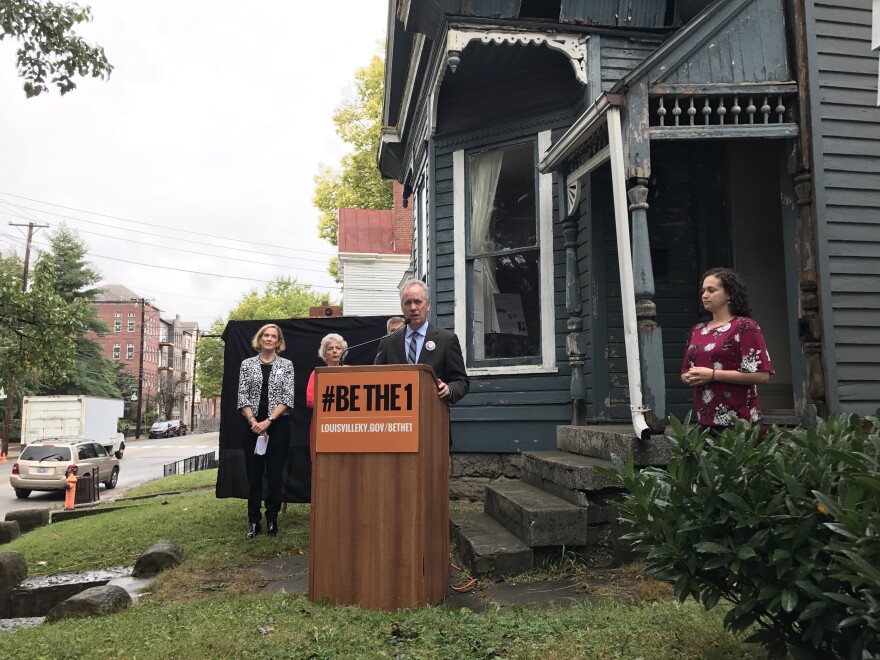The old house has crusty blue paint and a busted gutter. Elegant white trim is pocked and peeling and partly discolored.
To passersby on busy East Broadway, the house may appear to be an eyesore, another crumbling botch of blight.
Others see more.
This historic vacant house and four more along East Broadway will be transformed from derelict dumps to homes by a newly minted nonprofit group dedicated to historic preservation.
The group calls itself Vital Sites. It's a continuation of the Louisville Preservation Fund, which helped lead the redevelopment of the downtown Whiskey Row.
Vital Sites plans to pull together an array of funding sources — both public and private — to finance the redevelopment effort, which will bolster the city's stock of affordable housing. The group hopes to create a revolving funding mechanism that could lead to more historic preservation across Louisville.
Well-Worn, Worthy Debate
At a press conference to formally unveil the project on Monday, Vital Sites' board members were joined at the podium by Louisville Mayor Greg Fischer. The city's top development officers were in the crowd.
The houses set for revitalization sit in the growing shadow of two of the city's newest residential developments.
Together, those developments will yield hundreds of new apartments, parking garages and retail space along the East Broadway and Baxter Avenue corridors. The some $450 million combined cost of the two projects was offset by millions in public tax incentives.
The corridor presents a unique look at the well-worn local debate of preservation versus development.
For years, preservationist-minded residents and groups across the country have clamored to be heard over contractors and the bustling construction of new apartments, hotels and high-rises.
It's been no different in Louisville.
Most recently, preservationists clashed with developers as plans were being finalized to construct the Omni Hotel and Residences downtown. Preservationists wanted the developer to include in its design a century-old building that once housed the city's water company.
In the end, the building was destroyed. But from that debate came a new approach to preservation that is permeating contemporary development in Louisville.
After the Omni standoff, Fischer created atask forceto focus on historic preservation. The aim: to be proactive, not reactive, when it comes to preservation.
Still, it's not uncommon to hear city leaders tout what they call an "unprecedented" era of new development and investment in Louisville. They praise the rise of apartments and hotels. They provide tax incentives and cut ribbons with glee.
So, how do city leaders prioritize preserving historic structures and building new ones?
Mary Ellen Wiederwohl, who heads the city's economic development departments, said Louisville has to be a "both, and" city.
This means city officials have to be open to both development and preservation.
"There is an inherent tension between the two, but it doesn't have to be unhealthy," she said.
One way to do that, she said, is to be more proactive — pointing to the task force. She said, though, that preservation can't always win the day.
"Cities are dynamic places; they're always changing," she said. "If we simply preserved everything we've always done, we'd look exactly like we did in 1778."
In an interview Monday, Fischer repeated the "both, and" philosophy. He added that each project has individual demands.
"You have to take a look at the scale and scope of a project, dollar-wise, how many jobs it can bring to a community," he said.
Smaller preservation efforts — like the one on East Broadway — are easier and make sense. Having a developer that appreciates preservation is also helpful, Fischer said.
But the mayor has no demands for preservation when his administration enters into a discussion with a potential developer.
"You come in with a preservation mindset, with an affordable housing mindset, you come in with a development mindset, an overall jobs and equality mindset," he said.
Old Is New
The news conference to announce the redevelopment project lasted about 20 minutes. Afterward, the old house on East Broadway was again filled with life as the dozens of city officials, reporters, preservationists and others wandered through.
Valle Jones, a Vital Sites board member and developer of the Whiskey Row project, ran her hand along an old window, reveling in the light that streamed through.
"It's really incredible," she said.
And Christy Brown — a local philanthropist with a focus on preservation and health — admired the interior's tall ceilings and sliding doors.
"It's really beautiful," she said.


